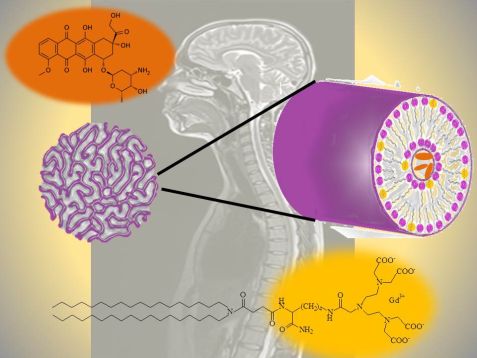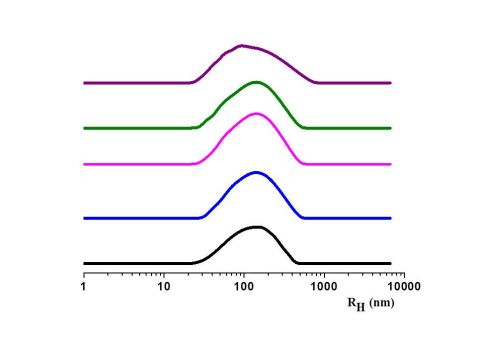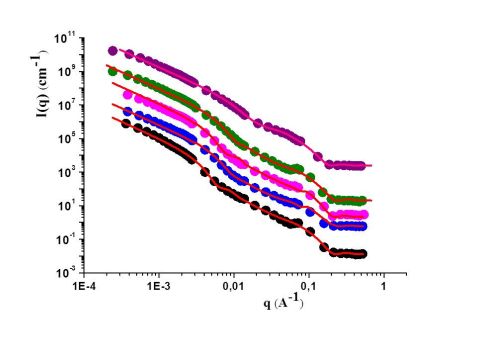MLZ ist eine Kooperation aus:
 > Technische Universität München
> Technische Universität München > Helmholtz-Zentrum Hereon
> Helmholtz-Zentrum Hereon
 > Forschungszentrum Jülich
> Forschungszentrum Jülich
MLZ ist Mitglied in:
 > LENS
> LENS > ERF-AISBL
> ERF-AISBL
MLZ in den sozialen Medien:

MLZ
Lichtenbergstr.1
85748 Garching
Structural insights into nanoparticles containing Gadolinium complexes as potential theranostics
L. Paduano1, A. Luchini1, N. Szekely2, V. Pipich2
1Department of Chemical Sciences, University of Naples “Federico II”, Napoli, Italy
2Jülich Centre for Neutron Science (JCNS) at MLZ, Forschungszentrum Jülich GmbH, Garching, Germany

The term “theranostics” refers to the currently expanding research field where suitably designed systems, able to combine diagnostic (PET and SPECT in combination with CT and/or MRI) and therapeutic modalities in one unified material, have promising applications. These multifunctional systems provide the opportunity to develop individually designed therapies against various diseases to achieve personalized medicine. In recent years, supramolecular aggregates containing Gd(III) complexes have been proposed as MRI Contrast Agents. In the present report, the design and characterization of 1-Oleylglycerol (MO) based nanostructures doped with a synthetic amphiphilic gadolinium complex (C18)2DTPA(Gd) are presented. The aim of this research is the development of well-defined and stable highly-ordered three dimensional mesophases for potential application as highly efficient MRI contrast agents. Moreover, drug-loading of the anticancer doxorubicin (Dox) in such nanostructures was also investigated for potential theranostic applications.
Development of a theranostic device
Among the recently proposed theranostic devices, liposomes, obtained via amphiphilic gadolinium complexes or by their co-aggregation with surfactants, as well as micelles, display higher efficacy with respect to MRI contrast agents based on isolated Gadolinium complexes. In addition to liposomes and micelles, amphiphilic molecules also aggregate in a water solution, giving a variety of higher order two (2D) or three (3D) nanostructures. In particular, 2D inverse hexagonal and 3D inverse cubic structures can be dispersed as stable particles, offering substantial advantages as compared to traditional supramolecular aggregates. Indeed, these nanostructures present much higher payloads of Gadolinium ions than micellar and liposomal systems with an expected increased relaxivity rate (1/T1) [2,3,4]. The improved relaxivity values are due to the presence of nano-scale water channels that offer a better environment for diffusion and fast exchange between gadolinium coordinated water and bulk water.
Here, we report on the structural characterization of new gadolinium based contrast agents obtained by co-aggregation of an amphiphilic gadolinium complex, (C18)2DTPA(Gd), with monoolein (MO). The nanostructures obtained display high relaxivity values. Since these nanostructures are also of interest for their application in drug controlled-release, their doxorubicin encapsulation capability was also evaluated.
Structure revealed by light and neutrons
Monolein (MO) nanoaggregates containing different amounts (in mol.) of (C18)2DTPA(Gd) amphiphilic gadolinium complex (0 %, A1; 1 %, A2; 5 %, A3; 10 %, A4 and 20 %, A5) and Pluronic F127 (PF127) at 15 % w/w were formulated.
The structural characterization was carried out by combining information obtained through Dynamic Light Scattering (DLS) and Small-Angle Neutron Scattering (SANS) measurements. In all the samples investigated, the DLS data revealed the presence of a single broad distribution of aggregates with mean hydrodynamic radius in the range of 70-200 nm (Fig. 2). The morphology of these aggregates, and their geometrical characteristics, were obtained through SANS measurements. Scattering cross sections for all systems studied (Fig. 3) showed the presence, in the low region, of a power law decay: (dΣ/dΩ) ∝ q-α, with α of about -3. According also to the Cryo-TEM image performed on selected samples (Fig. 4), this is due to the presence of bicontinuous aggregates. Fitting optimization, with an appropriate model of dΣ/dΩ vs. q made it possible to obtain structural parameters of the aggregates. The thickness of the bilayers was evaluated to be about 3 nm and the mean distance between the centers of the layers about 5 nm. All the different aggregates showed high relaxivity values per Gd complex (r1p ≈ 11 mM-1s-1 at 20 MHz and 298 K) and a Drug-Loading Capability (DLC) with respect to doxorubicin encapsulation of about 95 % at drug/lipid (w/w) ratio of 0.10.
Nanoparticles containing Gd-complex: major results
With the aim of introducing novel teranostic agents, the preparation and characterization of nanoaggregates of MO/PF127 containing the amphiphilic Gd-complex (C18)2DTPA-Gd were presented. Experimental evidence indicates that these are bicontinous aggregates. The relaxometric properties, the size and shape of the nanostructure, as well the Doxorubicin loading ability suggest the nanocompounds obtained could act as theranostics for simultaneous cancer therapy and MRI visualization.
References:
[1] A. Accardo et al., Colloid Polym Sci 292(5), 1121 (2014).
[2] A. Accardo et al., J. Pept. Sci. 19(4), 190 (2013).
[3] A. Accardo et al., Mol. BioSyst. 6(5), 878 (2010).
[4] M. Vaccaro et al., ChemPhysChem 8(17), 2526 (2007).
MLZ ist eine Kooperation aus:
 > Technische Universität München
> Technische Universität München > Helmholtz-Zentrum Hereon
> Helmholtz-Zentrum Hereon
 > Forschungszentrum Jülich
> Forschungszentrum Jülich
MLZ ist Mitglied in:
 > LENS
> LENS > ERF-AISBL
> ERF-AISBL
MLZ in den sozialen Medien:





